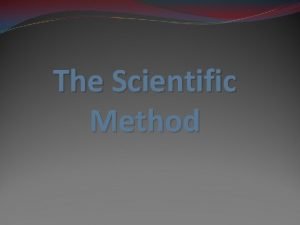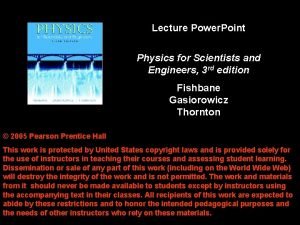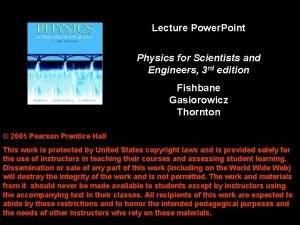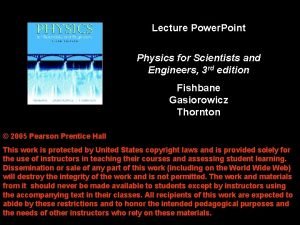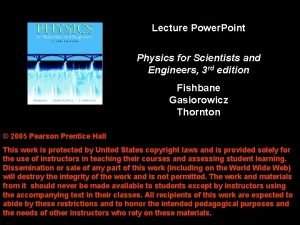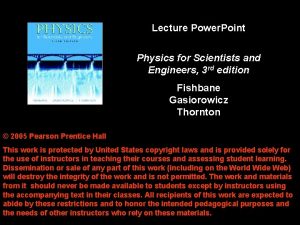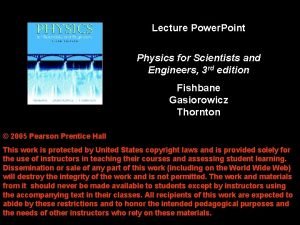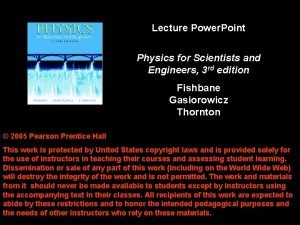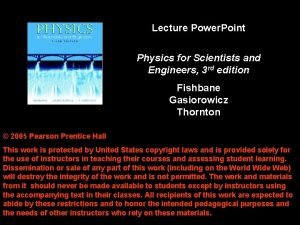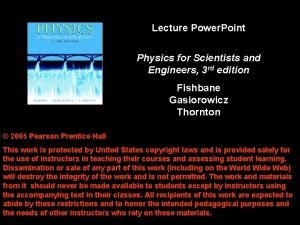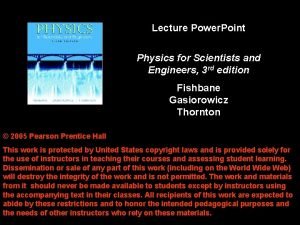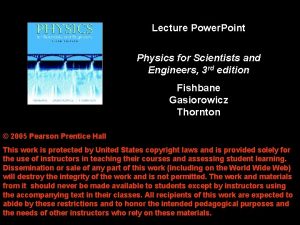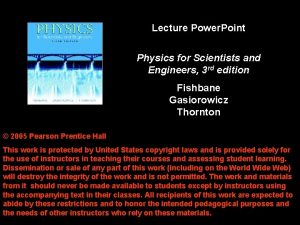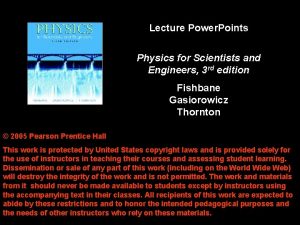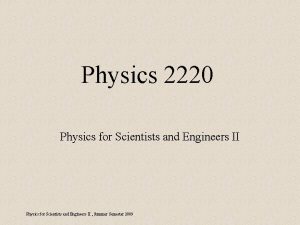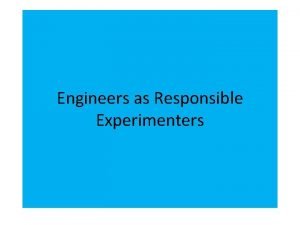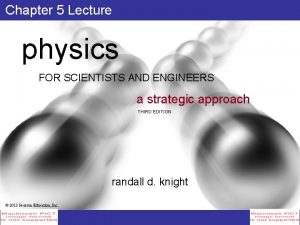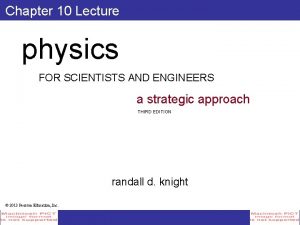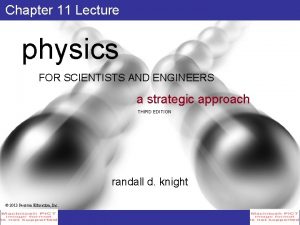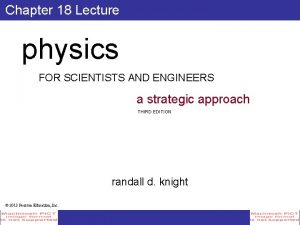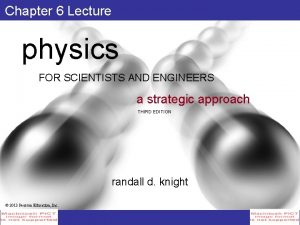Lecture Power Point Physics for Scientists and Engineers






















- Slides: 22

Lecture Power. Point Physics for Scientists and Engineers, 3 rd edition Fishbane Gasiorowicz Thornton © 2005 Pearson Prentice Hall This work is protected by United States copyright laws and is provided solely for the use of instructors in teaching their courses and assessing student learning. Dissemination or sale of any part of this work (including on the World Wide Web) will destroy the integrity of the work and is not permitted. The work and materials from it should never be made available to students except by instructors using the accompanying text in their classes. All recipients of this work are expected to abide by these restrictions and to honor the intended pedagogical purposes and the needs of other instructors who rely on these materials.

Chapter 28 The Effects of Magnetic Fields

Main Points of Chapter 28 • Magnets and magnetic fields; magnetic poles • Magnetic force on a point charge • Circular motion in a constant magnetic field • Lorentz force and velocity selectors • Magnetic forces on currents and current loops • Hall effect

28 -1 Magnets and Magnetic Fields • Forces between bar magnets: • Opposite poles attract • Like poles repel

28 -1 Magnets and Magnetic Fields • Magnetic field lines point from N poles to S poles • Magnetic fields can be mapped out using iron shavings:

28 -2 Magnetic Force on an Electric Charge • Moving electric charges are deflected by magnetic fields • By studying form and dependence of force, we find: (28 -1)

28 -2 Magnetic Force on an Electric Charge • The force is proportional to the charge, the velocity, the field, and the angle between the velocity and the field • The force is perpendicular to both the velocity and the field

28 -2 Magnetic Force on an Electric Charge Units of magnetic field: teslas (28 -3) The Lorentz force is the sum of the electric and magnetic forces acting on the same object: (28 -4)

28 -3 Consequences of the Magnetic Force on a Charge Circular Motion in a Constant Magnetic Field • The centripetal force is provided by the magnetic field • We can solve for the radius of the circle, knowing the charge’s speed: (28 -5)

28 -3 Consequences of the Magnetic Force on a Charge • Interestingly, the frequency of the circular motion does not depend on the speed: (28 -7) • This is called the cyclotron frequency.

28 -3 Consequences of the Magnetic Force on a Charge Velocity Selectors • A particle moving in a region where there are both electric and magnetic fields can experience no net force if: • The electric and magnetic fields are perpendicular to each other and to the particle’s velocity • The particle moves at a particular speed: (28 -9)

28 -3 Consequences of the Magnetic Force on a Charge-to-mass ratio of the electron • This can be measured by accelerating electrons through a known potential difference V, and then adjusting electric and magnetic fields so they are not deflected. (28 -11)

28 -4 Magnetic Forces on Currents • Currents consist of moving charges, so will experience force in magnetic field • Force on infinitely long wire is infinite; will look at force on wire segment instead (28 -14) • To find force on finite wire, must integrate

28 -4 Magnetic Forces on Currents For a straight wire of length L making an angle θ with the magnetic field: (28 -18) Or, defining the vector L as having the length of the wire and the direction of the current: (28 -19)

28 -5 Magnetic Force on Current Loops • Consider a rectangular loop in a constant magnetic field • Can easily find the force on each side of the loop • Forces cancel but, depending on orientation, there may be a torque

28 -5 Magnetic Force on Current Loops We define the magnetic moment of the loop: (28 -23) which allows us to write the torque in a simple form: (28 -22)

28 -5 Magnetic Force on Current Loops The galvanometer uses this effect to measure currents: A larger current means a larger torque. Galvanometers are at the heart of many ammeters and voltmeters.

28 -5 Magnetic Force on Current Loops A current loop in a magnetic field also has potential energy, depending on the angle it makes with the field: (28 -26) Here, ψ is the angle between µ and B.

28 -6 The Hall Effect • Place a conducting strip in a magnetic field, as shown • Force on charge carriers will move them to the left, regardless of their sign • Sign of the potential difference across the strip gives the sign of the charge carriers

Summary of Chapter 28 • Magnetic force on a moving charge: (28 -1) • Lorentz force: (28 -4) • A particle in a uniform magnetic field travels in a circle; its radius and frequency are: (28 -5) (28 -7)

Summary of Chapter 28, cont. • A particle in crossed electric and magnetic fields can experience no force if: (28 -9) • Force on an infinitesimal piece of wire: (28 -14) • And on a straight wire of length L: (28 -19)

Summary of Chapter 28, cont. • Torque on a current loop: (28 -22) where (28 -24) • Potential energy of a current loop: (28 -26)
 01:640:244 lecture notes - lecture 15: plat, idah, farad
01:640:244 lecture notes - lecture 15: plat, idah, farad Draw the power triangle
Draw the power triangle Power bi training powerpoint
Power bi training powerpoint Point point power
Point point power Power system dynamics and stability lecture notes
Power system dynamics and stability lecture notes Power system dynamics and stability lecture notes
Power system dynamics and stability lecture notes Physics 111 lecture notes
Physics 111 lecture notes What is a harmonic wave in physics
What is a harmonic wave in physics Phy101 lecture 1
Phy101 lecture 1 Physics 101 lecture notes pdf
Physics 101 lecture notes pdf Pdf
Pdf Atmospheric physics lecture notes
Atmospheric physics lecture notes Power system analysis lecture notes
Power system analysis lecture notes Power semiconductor devices lecture notes
Power semiconductor devices lecture notes Switch mode power supply lecture notes
Switch mode power supply lecture notes What is the point of uchendu’s lecture to okonkwo?
What is the point of uchendu’s lecture to okonkwo? Hub and spoke transportation
Hub and spoke transportation Sometimes scientists make a mistake or
Sometimes scientists make a mistake or Diagrams tables and graphs are used by scientists mainly to
Diagrams tables and graphs are used by scientists mainly to Modern physics vs classical physics
Modern physics vs classical physics University physics with modern physics fifteenth edition
University physics with modern physics fifteenth edition Ib physics
Ib physics Formuö
Formuö


















